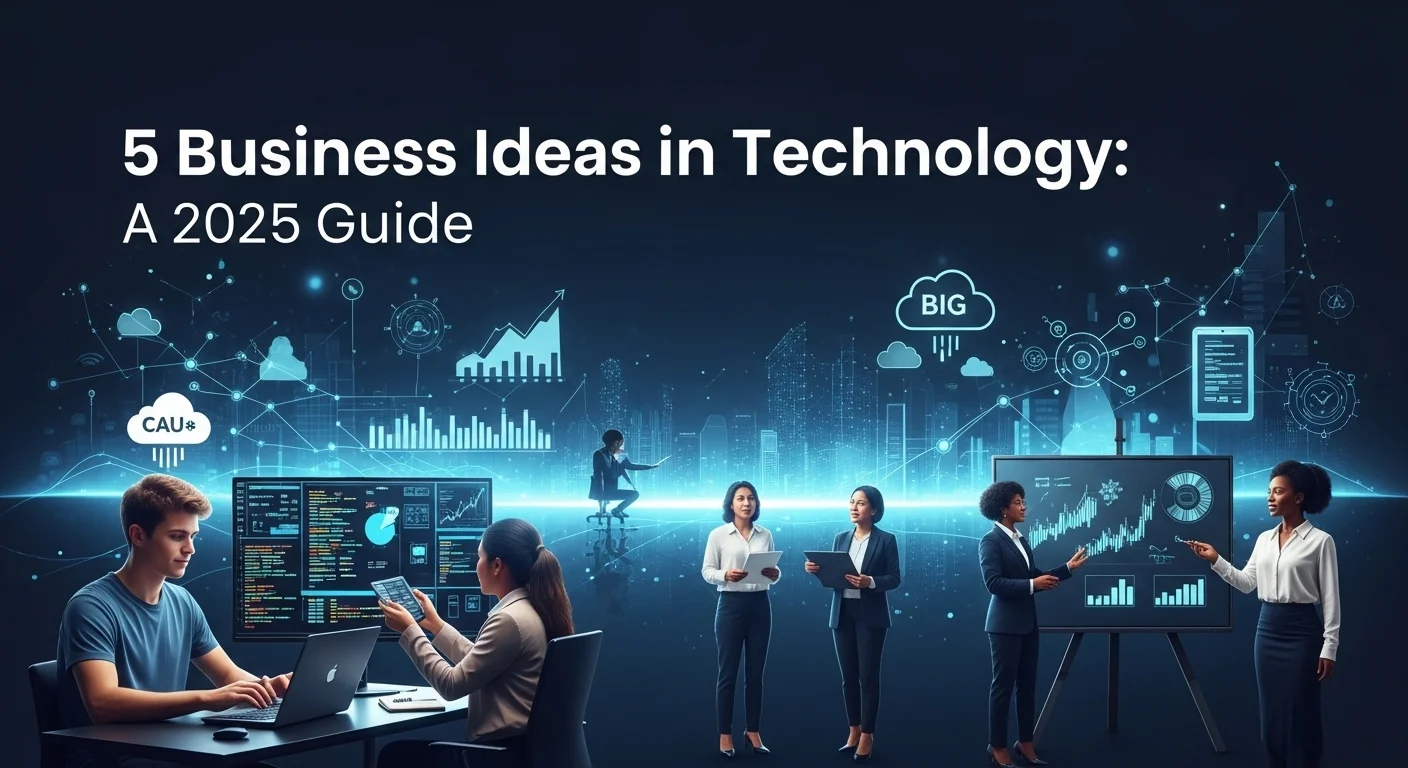5 Game-Changing Tech Business Ideas to Launch in 2025

Executive Summary
In my years of mentoring tech startups, I've seen countless trends come and go. The key to lasting success isn't chasing every new shiny object; it's identifying the fundamental shifts in technology and human needs. For 2025, I've pinpointed five specific domains that are not just trendy but have deep, sustainable potential. This guide is my personal breakdown of these opportunities, moving beyond the buzzwords to give you a real-world look at what it takes to build a successful company. We'll explore AI-driven analytics, essential cybersecurity for small businesses, bespoke cloud solutions, smart environment integration, and personalized education technology. My goal is simple: to give you a clear, honest roadmap based on my experience, helping you turn a powerful idea into a future-proof business that truly solves problems.
Table of Contents
Table of Contents
- AI-Powered Business Analytics as a Service
- Managed Cybersecurity Services for SMEs
- Custom Cloud Infrastructure Solutions
- IoT and Smart Environment Integration
- Personalized EdTech Platforms
Why Focusing on the Right Idea is Everything in Tech
In the fast-paced world of technology, your focus is your most valuable asset. I've seen brilliant founders burn out because they tried to do too much, too soon. That's why I always advise new entrepreneurs to build their strategy around a handful of truly promising ventures. It's a framework I've used for years to cut through the noise and zero in on what's next. It's about finding ideas that are at the intersection of powerful technology, clear market demand, and a real human need. When you find that sweet spot, you can pour all your energy into it, conduct deeper research, build a better product, and craft a message that truly resonates. This focused approach is especially critical for startups and small businesses that can't afford to spread their resources thin. It’s the difference between a venture that fizzles out and one that becomes a scalable, resilient company.
So, what are these core opportunities for 2025? After analyzing market trends and technological advancements, I've boiled it down to five key areas where new businesses can make a significant impact. These aren't just incremental improvements; they are foundational pillars of the next digital economy, built on AI, cybersecurity, the cloud, and IoT. Let's introduce them:
- AI-Powered Business Analytics as a Service: Businesses today are swimming in data but starving for wisdom. An AI analytics service provides that wisdom on a silver platter, using machine learning to uncover insights and predict trends that a human analyst could easily miss.
- Managed Cybersecurity Services for Small and Medium-sized Enterprises (SMEs): Cybercriminals love easy targets, and unfortunately, that often means small businesses. As a managed security provider, you become their digital guardian, offering enterprise-level protection at a price they can actually afford. The demand for this is exploding.
- Custom Cloud Infrastructure Solutions: 'One-size-fits-all' is dead in the cloud. Companies need tailored cloud setups—hybrid, multi-cloud—to optimize costs and performance. A business that specializes in designing these bespoke solutions is providing immense value, acting as a cloud architect for the modern digital business.
- IoT and Smart Environment Integration Services: We have more connected devices than ever, but getting them to work together in a smart, seamless way is a huge challenge. This business is about being the maestro of that orchestra, creating intelligent environments from smart offices to automated factories.
- Personalized EdTech Platforms: Education is moving away from a uniform curriculum to a customized journey. Using AI, these platforms adapt to each student's unique pace and style, making learning more effective and engaging. It’s a chance to revolutionize one of our most important sectors.
Each of these ideas represents a massive market opportunity backed by unstoppable trends. They are interconnected pieces of our digital future. AI provides the intelligence, cybersecurity provides the safety, the cloud provides the foundation, IoT connects our world, and EdTech empowers our people. By focusing on one of these areas, you're not just starting a business; you're building a solution to a fundamental challenge of our time.

A Deep Dive into 2025's Top Tech Ventures
Having a great idea is one thing; knowing how to execute it is another. I've been in the trenches with startups, and success always comes down to the details. Here's my complete breakdown of each of the five business ideas, covering the tech you'll need, the business strategies that work, and the resources you can lean on. This is the blueprint I wish I had when I was starting out.
1. AI-Powered Business Analytics as a Service (AaaS)
Technical Methods: From my experience, building an AI analytics tool means you're really a data translator. At the heart of it, you’ll use machine learning models (think Python with TensorFlow or PyTorch) for prediction and natural language processing (NLP) to make sense of text. Your infrastructure has to be rock-solid; we're talking about data warehouses like BigQuery and scalable cloud-native apps built with microservices and orchestrated with Kubernetes. This ensures you can handle vast amounts of client data without breaking a sweat.
Business Techniques: Don't try to be everything to everyone. I've seen startups succeed by focusing on one niche, like e-commerce analytics to optimize pricing, or healthcare to predict patient trends. The subscription model is your best friend here, with tiers based on data volume or feature access. Your best marketing tool is a case study or a white paper that shows, in plain English, how you helped a business make a smarter decision with your platform.
Available Resources: You don't have to build everything from scratch. Leverage pre-trained models from AWS SageMaker or Google AI Platform to get a head start. For the front-end dashboard, you can integrate open-source tools like Apache Superset, which saves a ton of development time.2. Managed Cybersecurity Services for SMEs
Technical Methods: Think of yourself as a digital bodyguard for small businesses. Your toolkit will include a SIEM system to monitor all activity, endpoint detection and response (EDR) agents on every device, and regular vulnerability scans to find weak spots before the bad guys do. The real skill isn't just in the tools, but in creating clear 'what-if' plans (incident response playbooks) for when an attack happens.
Business Techniques: Trust is your currency. You're not just selling software; you're selling peace of mind. A monthly retainer model works best, scaled by the number of employees or devices. Offer clear packages—like 'Essential' monitoring vs. a 'Complete' package with proactive threat hunting and employee training. Your clients won't understand the jargon, but they will understand a report that says, 'We stopped 15 threats this month.' Transparency is key.
Available Resources: To keep initial costs down, you can start with powerful open-source tools like Wazuh for security monitoring and OpenVAS for scanning. Partnering with established vendors like CrowdStrike for their EDR solutions can also give you instant credibility and firepower. The NIST Cybersecurity Framework is an excellent free guide for structuring your services.3. Custom Cloud Infrastructure Solutions
Business Techniques: The business model here is two-fold: project fees for designing and migrating a client's system, followed by a monthly retainer for managing and optimizing it. Your secret weapon is becoming an expert in FinOps—cloud financial operations. I can't tell you how many founders I've met who are terrified of their AWS bill. If you can show them how to cut costs by 30%, you're a hero. That's how you build a reputation in this space.
Technical Methods: To do this right, you need to live and breathe at least one major cloud platform (AWS, Azure, or GCP). Your core skill will be Infrastructure as Code (using tools like Terraform) to build automated, repeatable environments. Expertise in containers (Docker) and orchestration (Kubernetes) is non-negotiable for modern applications. You're the architect who designs a digital skyscraper that is efficient, strong, and won't bankrupt the owner.
Available Resources: The cloud providers themselves offer incredible free training and certifications. Use them. The Cloud Native Computing Foundation (CNCF) is your guide to the best open-source tools, and online communities on Reddit are like having thousands of colleagues to help you solve problems.4. IoT and Smart Environment Integration Services
Technical Methods: This isn't just about connecting smart plugs. We're talking about building the responsive environments of the future. You'll need to understand everything from the hardware protocols (like Zigbee or MQTT) to the cloud platforms that collect the data (like AWS IoT Core). The real magic happens in the application layer, where you create dashboards and write the rules that make everything work together seamlessly—'if this sensor detects a water leak, shut off the main valve and text the owner.'
Business Techniques: Niche down to win. Don't just be an 'IoT guy'; be the expert in 'smart solutions for commercial greenhouses' or 'assisted living safety monitoring.' This focus makes your marketing a hundred times easier. Partner with hardware makers or real estate developers to create a pipeline of projects. The pricing is typically a setup fee plus a monthly service contract for support and maintenance.
Available Resources: You can prototype new ideas cheaply with platforms like Raspberry Pi and Arduino. For the software logic, visual tools like Node-RED let you build complex automation flows without writing thousands of lines of code. It’s a great way to get started and show clients what’s possible.5. Personalized EdTech Platforms
Technical Methods: The soul of your platform is an adaptive learning algorithm. This AI model watches how a student performs and tailors the content to them in real time, making it easier when they struggle and more challenging when they succeed. To keep students hooked, you'll want to weave in gamification elements like points and badges. Most importantly, the user interface has to be incredibly intuitive and engaging for your specific audience, whether they're first-graders or corporate trainees.
Business Techniques: This is more than a business; it's a chance to change how people learn. You can sell directly to consumers (B2C) with a subscription model or sell licenses to schools and companies (B2B). If you're selling to a business, you need to prove a return on investment—show them how your platform gets their employees up to speed faster. For schools, aligning with their curriculum standards is a must. The social impact potential here is enormous.
Available Resources: You can build upon an open-source Learning Management System (LMS) like Moodle to save time. Content creation tools like Articulate 360 can help you design beautiful, interactive lessons. And again, the AI and machine learning tools from major cloud providers are readily available to power your adaptive engine.

Pro Tips for Turning These Ideas into a Thriving Business
Launching is just the first step. I've seen too many promising tech companies stumble because they didn't have the right strategies for growth. Here is some hard-won advice from my years in the field to help you build a sustainable and successful business across any of these five domains.
Foundational Strategies for Any Tech Startup
Before we get into specifics, these are the rules I tell every founder I mentor. They are non-negotiable.
- Start Small, Iterate Fast: Don't spend a year building the 'perfect' product. Launch a Minimum Viable Product (MVP) that solves one core problem for a small group of users. Then, listen to their feedback and improve in short, agile cycles. This is how you build something people actually love, not just something you think they want.
- Your Website is Your #1 Salesperson: Invest in a professional, clear, and fast website. Use a blog and case studies to prove you're an expert in your field. In tech, trust is built on competence, and your digital presence is your first chance to demonstrate it.
- Become Obsessed with Customer Success: Especially with subscription models, keeping customers is more important than getting them. Proactively check in, offer support, and help them achieve their goals using your service. Happy customers are your best marketing channel, and low churn is the secret to profitable growth.
- Data, Not Drama: Make decisions based on evidence. Track everything: user engagement, conversion funnels, support tickets. The data will tell you the truth about what's working and what isn't, long before your gut feeling does.
Specific Tips for Each Venture
1. AI-Powered Business Analytics
- Best Practices: Your biggest challenge won't be the tech; it'll be trust. Be radically transparent about how your AI works and how you protect client data. An 'explainable AI' that can justify its conclusions is far more valuable than a 'black box.'
- Business Tools: Use collaborative tools like Jupyter Notebooks for your data science work. For managing customer relationships, a CRM like HubSpot is essential from day one.
- My Advice: Offer a free pilot program using a potential client's own data (with a solid NDA). A live demonstration of the insights you can pull from their information is the most powerful sales pitch you can possibly make.
2. Managed Cybersecurity Services
- Best Practices: Your brand is built on reliability. The threat landscape changes every single day, so continuous learning for your team isn't optional, it's essential. Run regular 'fire drills' or tabletop exercises with your clients so they know exactly what to do in a crisis.
- Business Tools: A good Professional Services Automation (PSA) tool is the central nervous system of your business, managing tickets, billing, and projects. Secure documentation tools like IT Glue are non-negotiable for keeping client information safe.
- My Advice: Send a simple, graphical monthly security report. Avoid jargon. Use a 'security score' or highlight 'threats blocked.' This makes your invisible service feel tangible and proves its value month after month.
3. Custom Cloud Infrastructure Solutions
- Best Practices: As I mentioned, become a master of FinOps. Cloud cost optimization is the biggest pain point for many companies. If you can consistently save your clients money, they will never leave you. Build security and compliance into every design from the ground up.
- Business Tools: Use cost management tools like Harness to find savings opportunities for your clients. Project management software like Jira is crucial for handling complex migrations. And of course, Terraform is the industry standard for your core work.
- My Advice: Offer a free 'Cloud Health Check.' You'll analyze a prospect's current setup and give them a report with actionable recommendations. It's a fantastic way to showcase your expertise and generate highly qualified leads.
4. IoT and Smart Environment Integration
- Best Practices: Always think about the entire ecosystem, not just the individual devices. The user experience has to be dead simple. And remember, every connected device is a potential security risk. You must have a plan for authentication, encryption, and updates.
- Business Tools: Project management tools that can handle physical installations and inventory are key. On the software side, use a platform with a strong developer community like AWS IoT; it will save you countless hours.
- My Advice: Build a physical demo space. People need to touch and feel this technology to understand its power. Let them walk into a model smart room and see the lights adjust automatically or ask a voice assistant to book the space. An immersive experience is a thousand times better than a PowerPoint slide.
5. Personalized EdTech Platforms
- Best Practices: Partner with actual educators and learning scientists. They will keep your product grounded in sound teaching principles and prevent it from becoming just another tech gimmick. Prioritize accessibility to ensure your platform can be used by students of all abilities.
- Business Tools: You'll need a solid Content Management System (CMS) for your lesson library and a Learning Record Store (LRS) to track detailed user interactions. Use A/B testing to constantly refine learning pathways for better student outcomes.
- My Advice: Offer extended free trials to entire schools or corporate departments. Gather detailed feedback and testimonials. The most powerful thing you can show an administrator is a dashboard visualizing student progress and pinpointing where your platform helped someone finally grasp a difficult concept. Demonstrating that real impact is how you win in this space.
Expert Reviews & Testimonials
Sarah Johnson, Business Owner ⭐⭐⭐
This article laid out a solid foundation, but as a business owner, I'd love to see even more real-world case studies.
Mike Chen, IT Consultant ⭐⭐⭐⭐
A really useful breakdown. It clarified the landscape for me, though a few of the technical sections could be a touch simpler for non-specialists.
Emma Davis, Tech Expert ⭐⭐⭐⭐⭐
Fantastic and comprehensive guide. As a tech professional, I found the insights incredibly valuable and perfectly explained. Highly recommended.



